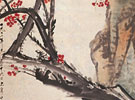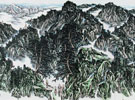I dagars första timmar kan medvetandet omfattar världen
som handen gripa en solvarm sten
- Thomas Tranströmer
In the first ray of daylight, consciousness can catch the world
Like the hand catches a warm stone under the sun
- Thomas Tranströmer (Swedish poet)
Kaimei Oisson Wang
Pan Xi paints women’s body with fluid water-based colour on Chinese silk. Each painting represents one woman. She paints them from their side, from their back. She paints their sensual breasts and rosy nipples exposed to us from behind their open shirts. Their body gestures, caught by the transparency of Chinese silk, are immaculate. They are dressed and yet undressed. Pan Xi paints beautiful clothes for them: gold and white lace in elegant patterns. Sometimes the laces are tight as if part of their skin: they reveal more of the body than conceal. Sometimes they fall behind in the background like extravagant drapery expanding the space where these women are in. The women sink in their own world, not responding to whosoever gazes at them - from whatever direction. They are self-contained, alone but not lonely. The smooth and fast drawn lines that embrace their body may remind you of the endless images of women in action in Degas’ world, but the purity within their body marks their existence as significantly different from the steamy hot Paris brothel. Nevertheless, the kind of seduction embodied in their gestures and actions is both sophisticated and sexy.
The women in Pan Xi’s paintings are also submerged in colourful and complicated background. The backgrounds are so well painted that sometimes they overtake the simplicity of the woman’s couture and become their extended second skin. We see golden laces with intricate patterns floating between the woman’s body and the night-blue dark background. Some crimson drops, red as the woman’s nail colour, spread all over on another white background in a seemingly casual manner. Pan Xi pays strong attention to create such background. They are like the colouristic summons in Matisse’ paintings, that makes our eyes spin and engages our full visual attention in what he called an experience of “aesthetic blinding”①. The women in Pan Xi’s paintings often have their faces omitted, however, we sense their self-indulgency in a very pleasant manner precisely by merging our viewing of the wome n with the complex background that surround them. As a great admirer of Matisse, Pan Xi tries to modulate her master’s skill with her female sensitivity. Her paintings stir up our visual experience more delicately than the great master.
With water-based pigment on water-absorbing Chinese silk, there is already some unpredicted spontaneity in the process of painting, but Pan Xi has more logic thinking behind each composition and each colour combination in her paintings. She received her professional artist training in Russia twenty years ago when the old-schooled academic guideline was still dominated by a more austere tradition. Perhaps the Western art training also helped to build up the rational way of thinking in her creative process. She sees this logic in the very material that she loves, namely, the lace. “You know why I am so fascinated by the lace?’ she says, “Except for its female delicate characteristic, I am more attracted by the repetitive intertwined patterns that show so much rationality behind its disorder and complicity. I love such complicated logic: underneath each act of spontaneity, there is always a logic.②”
The women in Pan Xi’s paintings are surrounded by a warm and intimate environment just as the artist herself is in. They enjoy the total freedom to be themselves in their private space. Pan Xi doesn’t use models. She painted these women that have always existed in her own mind with confidence and self-contentment. She exists with them in their aloneness, in their day-dreaming. Their state of mind eventually is her own. In this classical keyhole setting of the images, we watch these women staring at their own image in the mirror, their hands touching across their own body and their fingers twisting in their hair. We are the voyeurs that utterly enjoy what we have seen.
Twenty years ago, Pan Xi followed the Russian master on monumental mural, Professor V. N. Chelombiev to study mural painting. She had to approach art from the very essence of art making: with a heavy hammer in her hand, she learnt to make perfect mosaic out of rocks from the Ural mountain. Those very delicate hands of hers would feel much more at home when she came across a piece of Chinese silk on her father’s painting desk two years ago. Pan Xi’s father paints traditional landscape paintings with ink on rice paper. Silk is the material used for mounting the fragile rice paper. When she touched the soft silks with her fingers, she immediately thought about how it would be to paint on them. Her professionalism - one based on oil painting study - allows her to imagine how paintings on silk will look when they are stretched and mounted on frames. It was an experiment, but a successful one that offers her a new starting point in her artistic pursuit.
Pan Xi feels the freedom of dropping colour on the water-absorbing silk, and she controls such spontaneity with her refined logic. She also has designed the transparent acrylic glass frame to install her paintings in. When lights go through the clear frame and pass by the silk painting, the interplay between the light, the shadow and the colour on the silk all become integral parts of the whole aesthetic experience. It can even be in the manner of a classic Chinese poem: like layers of ice-white silk cut into countless pieces③, the metaphor of silk written by the poet emperor of Song Dynasty brings psychological calmness and sentimentality.
She chooses to be beautiful and she chooses to be sexy, she chooses to make her art the same: this is the very confidant attitude towards life of a mature Chinese female artist in our contemporary Chinese society.
①Matisse used the notion of “aesthetic of blinding” in response to critiques of his style of swirling background and figures in a blurred and blinded experience. See “Art Since 1900” Hal Foster, Rosalind Krauss and more, 2004, Thames& Hudson, P101
②Email communication between the writer and Pan Xi, 14th , March, 2011.
③From Zhao Jie, last emperor of Song Dynasty“ Yanshan Pavilion, En route to the north encountering apricot blossoms”




